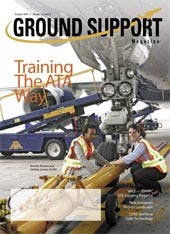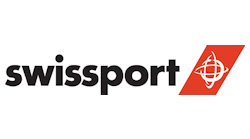ATA Strives to Maintain a Safe Workplace by Implementing Policies and Procedures that Reflect FAA, Environmental Protection Agency (EPA) and Occupational Safety Health Administration (OSHA) Standards.
October 2004
In many ways, ATA Airline's ground service training policies and procedures program paragons those of several other U.S. airlines, each possessing only minor differences, saving what is still a considerably unique footing in this industry. Two prominent women, Brenda Morton, supervisor of ground policy and education in station operations and Debbie Garner, IND ramp manager, are vanguards at the ATA headquarters in Indianapolis, IN. In the past 15 years, the ground support community has seen an increase in the number of women working on the ramp, yet our industry still lags behind when it comes to supervisory and administrative positions. ATA is changing that and their safety training.
Spirit of Indiana
Founded by George Mikelsons over thirty years ago, the airline has evolved from being an air travel club known as Ambassadair to American Trans Air Inc. as a common carrier to its current designation of major carrier and company name, ATA Airlines Inc. In 2002 they announced being the largest carrier from both Indianapolis International Airport (IND) and Chicago-Midway (MDW) and the third largest carrier overall in Chicago based on the number of passengers flown. Proud of its history in quality air transportation, ATA attributes a certain amount of its success to its safety record of which training is crucial. According to Morton, every employee is responsible for promoting safety in all phases of the company's operations, including personal safety, ground service equipment usage, environmental safety and safe actions working around the aircraft.
At ATA's Midway operations there are three duty managers and eighteen supervisors, 360 full and part-time ramp agents, fourteen gates and approximately eighty flights per day. At IND, ATA operates with four ramp supervisors, eighty-eight ramp agents, both full and part-time, four gates and approximately twenty flights each day. For 737's there is a crew of three to five and for 757's at least four to five. Training sessions are held approximately five times a year at IND and every three weeks at Midway with required annual re-current training and remedial training if an employee has an accident. Included in the Ground Service Training Manual used in the classroom are city and airline codes, security, aircraft characteristics, hand signals, baggage handling, ground servicing equipment, aircraft pushback and safety.
Grounded in Education
Prior to 1997, all of the ramp training at ATA was simply on-the-job training
(OJT) but since that time, ATA's comprehensive ramp training program
and department continues
to evolve as new safety professionals and instructors
come aboard. The most recent reorganization came this past January when the
department changed its name from System Ramp Training and Development to
Ground Policy and Education (GP&E). "Our
department gained the policy piece which used to be under customer service," explains
Morton. "In the last year and a half our group has become more involved
in the processes and developing the types of policy and education that will
be beneficial to the customer in improving their operations."
For example, GP&E, through extensive employee surveys, is in the process of evaluating their five day OJT and five day classroom training structure to determine the effectiveness and consistency of their policies primarily in their two main hubs, IND and Midway and ultimately at all of their 33 existing outstations as well. "We will be brainstorming to determine how we can improve our training product to be more effective and efficient for each station."
Currently, ATA employs its own ground handlers at IND and Midway. "ATA also relies on contracted vendors such as GlobeGround, ATS, Swissport, Servisair, Menzies and several others to handle our ground operations at our outstations," informs Morton. An ATA instructor travels to the scheduled service stations in the other cities and provides a "Train the Trainer" program which the outstation vendor is responsible for incorporating into their existing classroom sessions consisting of training on ATA ground handling differences specific to the handling of ATA aircraft. "For example, GlobeGround already has a comprehensive ramp training in place for their employees which compares with most of our material, however, there are some differences specific to ATA that we require," says Morton. "For instance, we chock the nose gear and the main gear but one difference is on departure, we don't pull the main chocks until the jetbridge is backed away from the aircraft." Howbeit, Morton notes that this program does not replace the ATA Ground Service Manual, which contains all policy for ramp services.
One of the advantages Morton enjoys at ATA is the "authority to make things happen with ease." "If a policy needs to be changed," says Morton, "there are not a lot of hoops to jump through - I'm able to leave my desk, visit the ramp and walk right back with concerns and to address them promptly." The GP&E department is constantly improving training, making sure to provide the best, innovative and most up-to-date materials on a monthly, sometimes daily basis.
Trends and Challenges
The recognition of the potential for threats and the use of preventative measures, known as "Human Factors" training and further concentration on injury/illness and accident prevention, are two of the trends that Morton sees on the ramp. "It's not just about policy on how to do your job anymore," explains Morton, "but having a complete understanding of your environment and developing safety responsibility behavior with each ramp agent and manager."
One of the systems that ATA has incorporated to enhance safety is through the use of color-coded safety vests. All ramp workers are required to wear vests on the ramp, however, ATA's workers' status can be distinguished by the color vest they don. Blue safety vests are issued to new-hire ramp agents for a probationary period of 90 days. After clear evidence of job performance proficiency they will graduate to yellow safety vests, only used by ramp service agents and 'lead' ramp service agents who also wear a 'LEAD' patch on the vest. Supervisors, like Morton and Garner wear orange vests with a 'SUPERVISOR' patch.
One of the biggest challenges that Garner and Morton face on the ramp is turnover and on-the-job training. Both agree that turnover can create an inconsistent workforce and that large classes, due to the ratio of trainees to instructor, diminish the individual focus. They are presently looking at different systems to enhance the coaching and mentoring part of the program. Different scenarios are being approached for IND and Midway.
Partnerships Are Imperitive
To date, there is no one organization requiring a specific safety and policy
procedures manual be used by the entire airline industry. Instead, each
airline has its own training and procedures program. "We would love
to get there," states Morton, "we just don't have a 'driver' out
there. In fact, one of our outstation vendors, who works with several carriers,
said recently, "Why don't we all have the same policies and
procedures' It's a different process with each one!"
But ATA and the other airlines work closely with the Air Transport Association, which is respected by government agencies such as the FAA, Environmental Protection Agency (EPA) and Occupational Safety Health Administration (OSHA) for the expertise and guidance it provides in several areas of the air transport industry including operations and safety. "Most companies send a manager or director to ATA and OSHA meetings ... with ATA Airlines, more people, including myself, get involved and it's nice as the 'little guy' to be part of such things. It gives me drive and elevates the passion I have for my job."
In addition to the necessary relationships with these agencies, Morton has to maintain a close relationship with customers like Garner who cannot operate without well-trained and educated employees. The two Communicate regularly and continually work together to streamline processes, develop new education classes and 'tweak' existing programs. "I love the closeness we have because we're a smaller company," says Morton. "I have great relationships with Safety, Medical Services and many others, and we work together fairly quickly and easily to make things happen."
Morton's group is developing a new relationship with Purdue University's Department of Aviation Technology (see sidebar) who has developed a realtime measurement system called the Purdue Safety Metrics. The system measures how safe the ramp is using observation checklists entered into a program which generate a report noting the safety items that need to be prioritzed.
"It's all about building relationships. That's where we find our success. Whether internally or externally, building rapport and gaining trust is how we are creating an enhanced program.
ATA is a small company but ground support is a small industry and throughout the industry, whether it's GSE, safety, policy and procedures or the employees themselves, it's all about sharing - it's all about community. "We all have friends in the industry and we all share our accomplishments and our mistakes so we can learn from one another," claims Morton. Oh if all of the world could only operate in such a manner.
Under a recent grant from the FAA, the Purdue University's Department of Aviation Technology developed and tested a safety improvement strategy which proved highly effective at reducing daily safety risks. The strategy uses daily observations of employee 'at-risk' behaviors which are captured and reported by software developed specifically for the program to report and correct these risky behaviors before they can become accidents or safety incidents. The program can be downloaded from the web for use by any company desiring to implement the strategy in their operations (http://www.tech.purdue.edu/at/resources/hfrp/index.htm or http://hfskyway.faa.gov/jobaids.htm). The program has also developed a safety and productivity strategy called 'process mapping' which is highly effective at identifying, defining and resolving safety and productivity problems in daily aviation operations. An online education program on how to use the strategy is currently being produced under a grant from NASA and will be available soon.
Current Projects:
- On-time process improvement
- Safety metric implementation at a major airline
- Employee injury study and ergonomic task analysis
- Procedural compliance at a major airline
- Third-party maintenance productivity and safety improvement
- Third-party maintenance MRO standards development
- Ramp safety education
- Corporate flight department safety assessment and standards
- Emergency disaster plan development for corporate flight department






